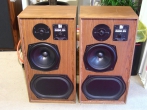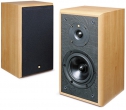KEF iQ70 loor standing speakers
The manufacturer, having speaker systems of various classes in its assortment, from entry-level to High End, must clearly position not only each line, but also all models within it, otherwise the buyer will be confused and will not be able to make a choice. And the task is not so much theoretical as engineering - to create a number of products with clearly different consumer properties is not as simple as it might seem at first glance.
KEF copes with this problem easily due to the abundance of proven solutions, the availability of its own drivers of various classes and the ability to manufacture cases of any complexity. Combining these factors, you can get a huge number of combinations that you can never confuse with each other. Although, as we will see a little later, it is still possible to be deceived.
As an example, take the iQ70, the second model from the top of the new KEF iQ series. The line itself is designed for music and film lovers on a budget and includes six systems for various purposes: three floor-standing (iQ50, iQ70, iQ90), two shelf (iQ10, iQ30) and a center channel (iQ60). But outwardly - according to the shape of the case and the "fairing" on the upper edge - they can easily be confused with the elite Reference models.
In turn, the floor standing iQ70 is a somewhat smaller copy of the iQ90 and is positioned as a front speaker in a home cinema system or a stereo pair for a medium-sized room.
2.5-way system, i.e. it has three drivers, but the filters are only between the midbass and the tweeter, combined into a consistent Uni-Q design. Midbass and woofer work in the same band, but since they have different frequency responses, they do not overlap completely. This design has both pros and cons. Pluses - simplicity and low cost, as well as the ability to use filters with a minimum number of elements, which favorably affects the sound. Cons - increased intermodulation, since unfiltered bass still gets into the midrange. It is clear that this is a compromise, but the compromise in these conditions is minimal.
The Uni-Q assembly has a very complex design, but it achieves dispersion characteristics close to that of a point source. At the center of the 165mm midrange is a lightweight aluminum dome tweeter capable of reproducing frequencies up to 40Hz. Tangerine waveguide is used to improve dispersion
The cone of the bass driver with a diameter of 165 mm is made of cellulose reinforced with natural fibers. This material has all the necessary qualities - low weight, high rigidity and effective absorption of internal resonances. The suspension is made of soft rubber, which, in combination with a high elliptical profile, increases the amplitude of vibrations with minimal distortion. The die-cast aluminum basket and powerful magnet system are borrowed from more expensive heads.
The Uni-Q assembly uses a Tangerine waveguide that expands the scatter pattern in the horizontal plane. Its effectiveness is really noticeable, which gives a clearer localization of sources and the correct stereo image even when the speakers are not symmetrically positioned relative to the listener.
The shape of the hull is streamlined, with a rounded rear wall, which creates additional obstacles for the occurrence of standing waves. Inside there is a system of partitions and couplers, which increase the rigidity and, accordingly, eliminate the coloration of the sound. The radiators and the bass reflex port have external flanges made of aluminum, obviously with an eye on aerodynamics. On top, as well as in the Reference models, there is a firework made of aluminum with an anti-vibration coating.
There are four input terminals, these are high-quality isolated WBTs with flexible wire jumpers.
The speaker system is installed on a plastic base (in my opinion, too thin and undignified for such a case), into which spikes are screwed. Exterior finish options are two varieties of walnut, black ash, light oak and dark apple.
The sound of the iQ70 is recognizable from the very first minutes - fast, continuous, with a three-dimensional panorama and a transparent upper range. As always, the characteristic clear joining of the mid- and high-frequency bands - strings, wind and brass instruments form a single group in terms of timbre composition, while individual performers are confidently positioned along the depth and width of the stage. The woodwinds sound natural, without horn coloring, and the cymbals and triangle literally crumble with silver.
The listening experience is clearly better than the Kenwood amplifier. At low volume levels, the sound quality is very good, both in terms of color and spatial perception.
The lower register itself is also not bad - the bass is deep, confident, although sometimes a little blurry. Sharp transitions from forte to piano are moderately contrasting, without unnecessary overtones. The atmosphere is conveyed in relief, sometimes even the details of the background seem too accentuated. But there is one feature that requires very careful attention to the installation of speakers - sometimes it seems as if the bass "walks by itself", as in carelessly docked 2.1 systems. Perhaps this mismatch occurs due to unconventional acoustic design (5th order phase inverter), which is more typical for a subwoofer than for a multi-band speaker. But you can tie the bass by installing the speakers on massive slabs (preferably marble), and no closer than one meter from the side wall. In this case, you will get a balanced and very detailed sound, and you don't need a powerful amplifier for this - the iQ70 has a sensitivity that is sufficient even to work with tube equipment.




